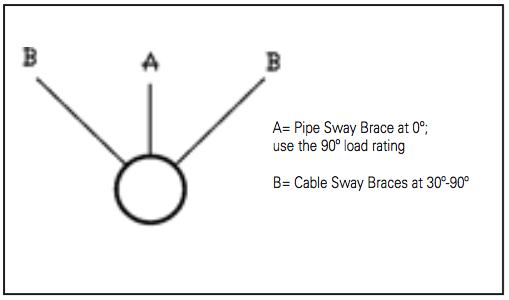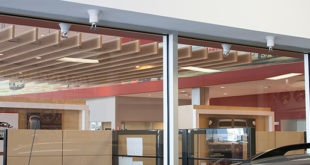Additional Rigid Braces are Required
Using 2013 NFPA 13, Standard for the Installation of Sprinkler Systems, as a reference, I will discuss this common tension-only sway brace misapplication. Many manufacturers of tension-only brace product incorrectly specify the installation of a rod hanger with a rod stiffener to resist upward vertical seismic force. When questioned on their recommendation they lack sound reasoning and tend to cite common practice or incorrectly reference the criteria of NFPA 13 – 9.3.6 Restraint of Branch Lines. Specifying restraint criteria as bracing is contrary to NFPA 13 section 9.3 and specifically 9.3.5.4.2.(8). When resistance to this vertical seismic force is required, NFPA 13 requires a rigid brace be installed in combination with tension-only braces. The following is a review of sway brace mechanics and the requirements of NFPA 13.
Since tension-only bracing has no ability in compression, two brace assemblies must always be installed opposing each other. This allows one of the two assemblies to always act in tension when bracing against horizontal seismic force. Since neither brace assembly has ability in compression, they then also lack the ability to resist vertical seismic force. Tension-only braces require the assistance of a rigid sway brace acting in compression to resist vertical seismic force per NFPA 13 – 9.3.5.1.1 and 9.3.5.10.
Knowing that a hanger assembly with a rod stiffener is all too often incorrectly installed at this location, let’s review the pertinent criteria. This hanger must meet the sway brace listing criteria specified by NFPA 13 – 9.3.5.2.1 and 9.3.5.2.2.1 by evidencing listed ability in compression, including a rated sway brace load. This hanger is always deficient in design and material because it is not designed nor listed for this application. The top hanger product such as a beam clamp or angle bracket and the bottom hanger product such as a pipe ring are listed only in tension as hanger components.

As a practical solution to resist vertical seismic force, most fire sprinkler contractors install an additional NFPA 13 pipe sway brace adjacent to the tension-only bracing. The available variety of UL-Listed product for pipe makes it the convenient choice of the fire sprinkler industry as a rigid, sway brace element.
SOLUTION: Install a pipe sway brace at location A – per the above drawing (Figure 1).
Please call AFCON at (626) 444-0541 with any questions or comments to this article.
IMPORTANT NOTICE: As a member of the NFPA 13 Hanging and Bracing Committee, the following disclaimer applies. The article and its content is not a Formal Interpretation issued pursuant to NFPA regulations. Any opinion expressed is the personal opinion of the author and presenter and does not necessarily represent the official position of the NFPA and its technical committee.
ABOUT THE AUTHOR: Kraig Kirschner, AFCON, is a third-generation fire sprinkler contractor and a journeyman fitter. He is a principal member of NFPA 13 Hanging and Bracing Technical Committee and serves on Standard Technical Panels of UL 203, UL 203A and FM 1950. Kirschner is a life member of the National Fire Protection Association and was named Person of the Year in 2009 Fire Protection Contractor Magazine. He holds dozens of patents that enhance the installation and application of hangers and sway braces.
 Sprinkler Age A Publication of the American Fire Sprinkler Association
Sprinkler Age A Publication of the American Fire Sprinkler Association

